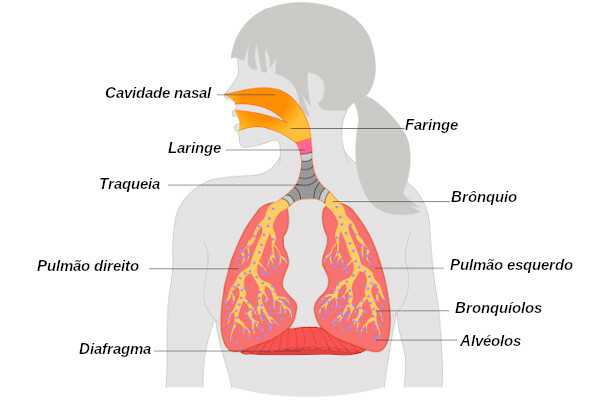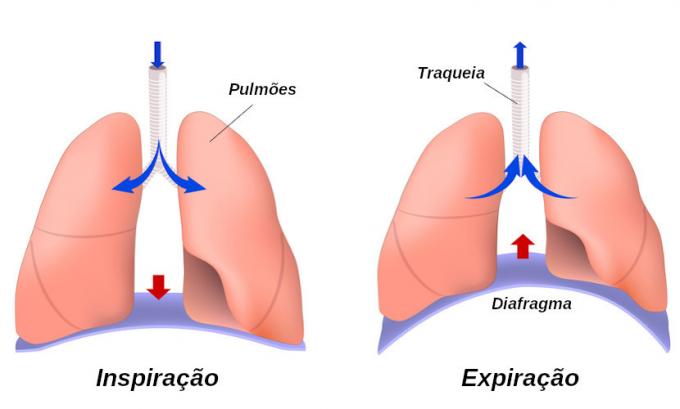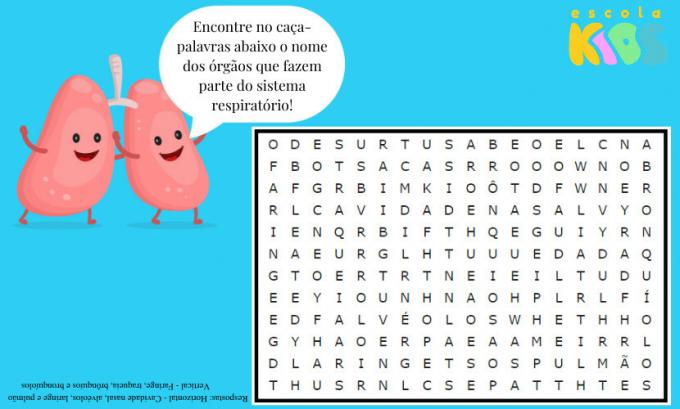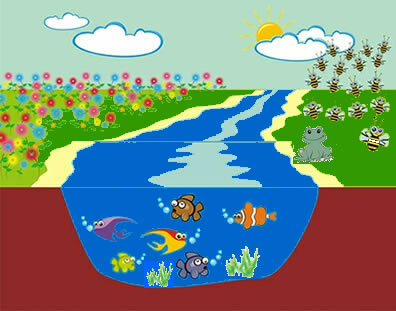O respiratory system is the body's system responsible for ensuring the uptake of oxygen present in the air and the elimination of carbon dioxide from the our body. The oxygen taken up by our respiratory system is carried to all our cells and used in energy production (cellular respiration). In the energy manufacturing process, carbon dioxide is produced, which is then eliminated from the body by the respiratory system as well. It is worth noting that, in addition to participating in breathing, this system has structures that ensure the production of sounds and perception of odors.
Our respiratory system is made up of:
- nasal cavity;
- pharynx;
- larynx;
- trachea;
- bronchi;
- bronchioles;
- pulmonary alveoli.
Bronchi, bronchioles and pulmonary alveoli are located within the lungs, two pinkish-colored organs and spongy appearance.

The path of air in our body
Below we will present the path taken by the air from its entry through the nostrils until reaching our lungs:
- Nasal cavities: the air enters our body through the nostrils (openings in our nose) and goes to the nasal cavities. The hairs and mucus present in these cavities help to filter the air, removing impurities such as dust and microorganisms. Mucus also helps moisten the air we breathe. In this cavity, in addition to the air being filtered and humidified, it is heated, thanks to the large number of blood vessels in the area, which allow the heat of the blood to warm it.
- Pharynx: after leaving the nasal cavity, the air goes to the pharynx. This body is so much part of the digestive system how much of the respiratory. That is why we are able to breathe through our mouths as well, as the two systems are interconnected.
Now that you understand the importance of breathing through your nose, can you answer why we shouldn't breathe through your mouth? The answer is quite simple! In the mouth, the air is not efficiently heated, humidified and filtered, as in the nose. |
- Larynx: after passing through the pharynx, the air moves towards the larynx. In this place, the vocal folds are present, which vibrate with the passage of air and ensure the production of sounds. It is noteworthy that in the larynx there is also a structure called the epiglottis. When food is swallowed, the epiglottis prevents the food from passing into the trachea, ensuring that it travels into the esophagus.
- Trachea: the larynx ends in the trachea, a tube that is formed by rings of cartilage. These rings are important as they prevent them from closing, which could impede the passage of air.
- bronchi: the trachea divides into two bronchi, which penetrate the lungs.
- Bronchioles: the bronchioles are branches of the bronchi.
- Pulmonary alveoli: at the end of each bronchiole, we have the pulmonary alveoli, which are small sacs surrounded by several blood capillaries. It is in the capillaries that oxygen from the air passes into the blood and that the carbon dioxide present in the blood passes into the alveoli, a process called bruise. Carbon dioxide takes the opposite way to what we described, being expelled from the body in the exhalation process.

breathing movements
Breathing movements ensure the entry and exit of air from the lungs. On inspiration, air enters our lungs; on exhalation, it leaves.
At inspiration, the diaphragm (muscle found just below the lungs) and the intercostal muscles (muscles located between the ribs) contract. The diaphragm stretches the chest cavity and the intercostal muscles lift the ribs. These actions lead to an increase in the rib cage and a decrease in pressure inside the lungs, causing air to be inhaled. already in expiration, the intercostal muscles and diaphragm relax, causing a reduction in the volume of the rib cage and increasing the pressure inside the lungs. To learn more, read: breathing movements.

Read too: Cellular Breathing - How Do Cells Get Energy?
Respiratory system word search
Now that you know a little more about the respiratory system, find the names of the organs of that system in the word search below. Attention: the words are hidden horizontally and vertically.

Did you find all the words? In this word search you would have to find the following words: nasal cavity, alveoli, larynx and lung, horizontally; and pharynx, trachea, bronchi and bronchioles, vertically.



